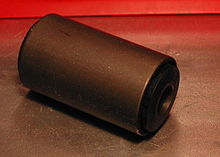
Stellantis North America, officially FCA US, LLC and formerly Chrysler, is one of the "Big Three" automobile manufacturers in the United States, headquartered in Auburn Hills, Michigan. It is the American subsidiary of the multinational automotive company Stellantis. In addition to the Chrysler brand, Stellantis North America sells vehicles worldwide under the Dodge, Jeep, and Ram nameplates. It also includes Mopar, its automotive parts and accessories division, and SRT, its performance automobile division.

Vehicle audio is equipment installed in a car or other vehicle to provide in-car entertainment and information for the vehicle occupants. Until the 1950s it consisted of a simple AM radio. Additions since then have included FM radio (1952), 8-track tape players, cassette players, record players, CD players, DVD players, Blu-ray players, navigation systems, Bluetooth telephone integration, and smartphone controllers like CarPlay and Android Auto. Once controlled from the dashboard with a few buttons, they can now be controlled by steering wheel controls and voice commands.

A shock absorber or damper is a mechanical or hydraulic device designed to absorb and damp shock impulses. It does this by converting the kinetic energy of the shock into another form of energy which is then dissipated. Most shock absorbers are a form of dashpot.

Lido Anthony "Lee" Iacocca was an American automobile executive best known for the development of the Ford Mustang, Continental Mark III, and Ford Pinto cars while at the Ford Motor Company in the 1960s, and for reviving the Chrysler Corporation as its CEO during the 1980s. He was president and CEO of Chrysler from 1978 and chairman from 1979, until his retirement at the end of 1992. He was one of the few executives to preside over the operations of two of the United States' Big Three automakers.

The unsprung mass of a vehicle is the mass of the suspension, wheels or tracks, and other components directly connected to them. This contrasts with the sprung mass supported by the suspension, which includes the body and other components within or attached to it. Components of the unsprung mass include the wheel axles, wheel bearings, wheel hubs, tires, and a portion of the weight of driveshafts, springs, shock absorbers, and suspension links. Brakes that are mounted inboard are part of a vehicle's sprung mass.

Suspension is the system of tires, tire air, springs, shock absorbers and linkages that connects a vehicle to its wheels and allows relative motion between the two. Suspension systems must support both road holding/handling and ride quality, which are at odds with each other. The tuning of suspensions involves finding the right compromise. It is important for the suspension to keep the road wheel in contact with the road surface as much as possible, because all the road or ground forces acting on the vehicle do so through the contact patches of the tires. The suspension also protects the vehicle itself and any cargo or luggage from damage and wear. The design of front and rear suspension of a car may be different.

The Plymouth Reliant and Dodge Aries are mid size cars introduced for model year 1981 as the first "K-cars" manufactured and marketed by the Chrysler Corporation. The Reliant and Aries were the smallest cars to have the traditional 6 passenger 2 bench seat with column shifter seating arrangement favored by customers in the United States, similar to larger rear-wheel drive cars such as the Dodge Dart and other front-wheel drive cars such as the Chevrolet Celebrity. The Reliant was powered by a then-new 2.2 L I4 SOHC engine, with a Mitsubishi "Silent Shaft" 2.6 L as an option. The Reliant was available as a 2-door coupe, 4-door sedan, or as a 4-door station wagon, in three different trim lines: base, Custom and SE. Station wagons came only in Custom or SE trim.

The K-car platform was a key automotive design platform introduced by Chrysler Corporation for the 1981 model year, featuring a transverse engine, front-wheel drive, independent front and semi-independent rear suspension configuration—a stark departure from the company's previous reliance on solid axle, rear-drive unibody configurations during the 1970s. Derived from Chrysler's L-cars, the Plymouth Horizon and Dodge Omni, the platform was developed just as the company faltered in the market, at first underpinning a modest range of compact/mid-size sedans and wagons—and eventually underpinning nearly fifty different models, including all-wheel drive variants—and playing a vital role in the company's subsequent resurgence.
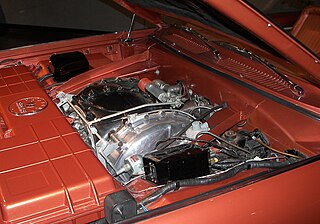
The Chrysler turbine engine is a series of gas turbine engines developed by Chrysler intended to be used in road vehicles. In 1954, Chrysler Corporation disclosed the development and successful road testing of a production model Plymouth sport coupe which was powered by a turbine engine.

The Dodge Aspen, and the nearly-identical PlymouthVolaré, are compact cars that were produced from 1976 until 1980. The Volaré/Aspen model line offered a four-door sedan, a two-door coupe, and a four-door wagon.
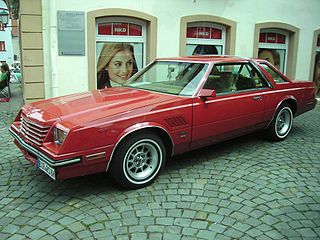
The Dodge Mirada is a mid-sized, rear-wheel drive coupe manufactured and marketed by Dodge for the model years 1980 to 1983, sharing the Chrysler J platform along with its badge engineered variants, the second generation Chrysler Cordoba and the Imperial. Production of the Mirada reached just under 53,000 units, staying relatively unchanged during its four-year run, with the exception of paint colors and engines. The Mirada was marketed as a sporty personal luxury car with limited advertising and marketing during a period when Chrysler was in deep financial difficulty.

The Chapman strut is a design of independent rear suspension used for light cars, particularly sports and racing cars. It takes its name from, and is best known for its use by, Colin Chapman of Lotus.

The Hotchkiss drive is a shaft drive form of power transmission. It was the dominant means for front-engine, rear-wheel drive layout cars in the 20th century. The name comes from the French automobile manufacturer Hotchkiss, although other makers, such as Peerless, used similar systems before Hotchkiss.
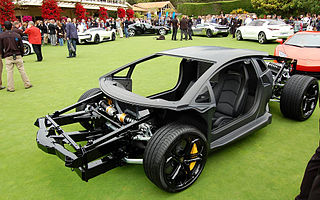
A subframe is a structural component of a vehicle, such as an automobile or an aircraft, that uses a discrete, separate structure within a larger body-on-frame or unit body to carry certain components, such as the engine, drivetrain, or suspension. The subframe is bolted and/or welded to the vehicle. When bolted, it is sometimes equipped with rubber bushings or springs to dampen vibration.
Vibration isolation is the process of isolating an object, such as a piece of equipment, from the source of vibrations. Vibration is undesirable in many domains, primarily engineered systems and habitable spaces, and methods have been developed to prevent the transfer of vibration to such systems. Vibrations propagate via mechanical waves and certain mechanical linkages conduct vibrations more efficiently than others. Passive vibration isolation makes use of materials and mechanical linkages that absorb and damp these mechanical waves. Active vibration isolation involves sensors and actuators that produce disruptive interference that cancels-out incoming vibration.
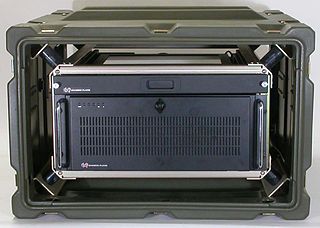
A shock mount or isolation mount is a mechanical fastener that connects two parts elastically. They are used for shock and vibration isolation.

Jaguar's independent rear suspension (IRS) unit has been a common component of a number of Jaguar production cars since 1961, passing through two major changes of configuration up to 2006 and last used in the Jaguar XK8 and Aston Martin DB7. This article concentrates on the first generation Jaguar IRS, which firmly established the marque's reputation for suspension sophistication, combining as it did smooth ride with excellent roadholding and low levels of noise, vibration, and harshness (NVH). The two generations overlap in time due to their being used in both full size and sports models that were updated at different times.

The history of Chrysler involves engineering innovations, high finance, wide alternations of profits and losses, various mergers and acquisitions, and multinationalization. Chrysler, a large automobile manufacturer, was founded in the 1920s and continues under the name Stellantis North America.

Owen Ray Skelton was an American automotive industry engineer and automobile designer. Along with Fred M. Zeder and Carl Breer, he was one of the core group who formed the present day Chrysler Corporation. He made material contributions to Tourist Automobile Company, Allis-Chalmers, Studebaker, and was the main engineer behind the Chrysler Airflow automobile. He was elected to the Automotive Hall of Fame in 2002.

The Three Musketeers is a nickname given to a team of three Studebaker engineers, Frederick Morrell Zeder, Owen Ray Skelton, and Carl Breer. They would become instrumental in the founding of the Chrysler Corporation, and were hand-picked by Walter Chrysler to come with him when he started the new company.
